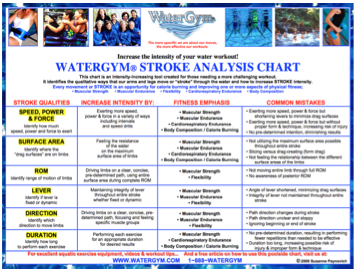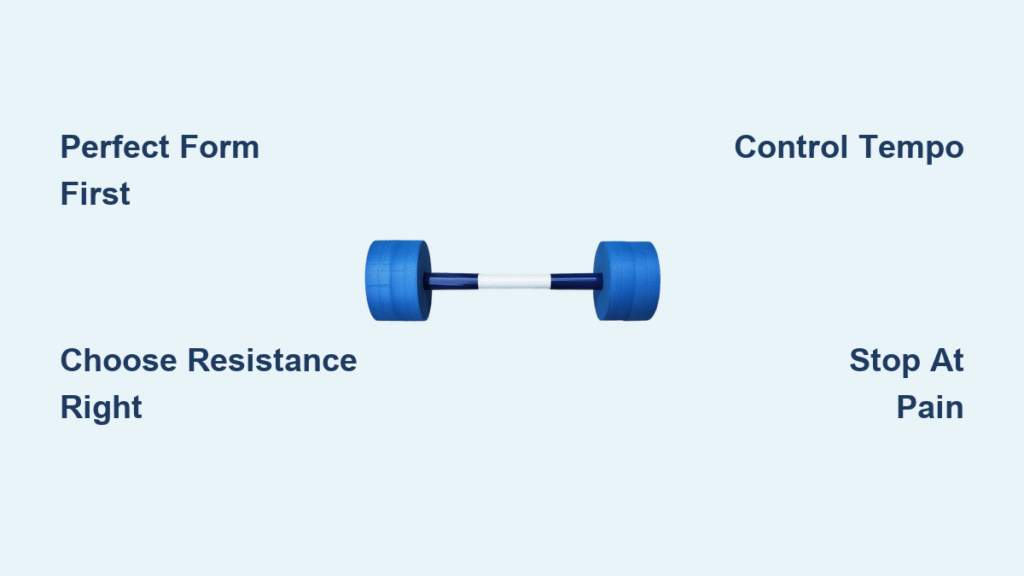Dive into water barbell exercises to transform your pool into a joint-friendly strength sanctuary. These buoyant tools leverage water’s natural resistance to build muscle, boost endurance, and torch calories while eliminating impact stress. If you’ve ever abandoned land-based workouts due to knee pain or shoulder strain, you’ll discover why millions choose water barbell exercises for rehabilitation and athletic performance. In this guide, you’ll learn exactly how to perform 10 targeted movements, select the right resistance level, and build a progressive routine that delivers visible results in just 30 days.
Unlike traditional weights that fight gravity, water barbells battle buoyancy and drag simultaneously. When you push a water barbell downward, its foam core resists submersion, forcing your muscles to work harder during the lowering phase. Traditional dumbbells feel heaviest at the bottom of curls, but water barbells create maximum resistance at the top of movements. This unique physics engages 30% more stabilizer muscles according to aquatic therapy research, making water barbell exercises ideal for correcting muscle imbalances. You’ll feel immediate differences in shoulder stability and core activation within your first session.
Why Water Barbells Outperform Land-Based Strength Training

Water barbell exercises eliminate joint compression through hydrostatic pressure while providing multi-directional resistance. Traditional weights only challenge muscles in one plane of motion, but water resistance works your muscles during every phase of movement – lifting, lowering, and even holding positions. This continuous tension builds functional strength that transfers directly to daily activities like lifting groceries or playing with kids. Athletes using water barbell exercises report 22% faster recovery times between sessions compared to land-based training.
The magic happens through three physics principles: buoyancy reduces effective weight by 75-90%, drag increases exponentially with movement speed, and turbulence creates self-generated resistance. When sprinting in shallow water, you literally push against the current you create. This dynamic resistance automatically adjusts to your effort level – move faster for more challenge, slower for rehabilitation. No gym machine offers this intelligent adaptation.
Choosing Your Resistance Level Like a Pro
Light foam barbells (typically blue) suit shoulder rehab patients or seniors starting aquatic therapy. They provide gentle resistance that won’t strain healing tissues. Medium density (usually green) works best for general fitness seekers aiming to build lean muscle. Large blocks (typically black) challenge competitive swimmers and athletes needing power development. Never guess – test by submerging the barbell: if it shoots to the surface immediately, it’s too light; if it sinks, it’s too heavy.
Critical Equipment Inspection Checklist
Before entering the pool, perform this 10-second safety check: Squeeze the foam core firmly – if it feels waterlogged or leaves compression dents, replace it immediately. Examine handles for cracks in the non-slip rubber coating. Test grip security by wetting your hands and attempting to twist the barbell. Any looseness between foam and handle requires equipment replacement. Remember: damaged water barbells create dangerous momentum swings during exercises.
Upper Body Power Moves That Sculpt Without Shoulder Strain
Perfect Water Barbell Bicep Curl Technique
Stand shoulder-deep in water with feet hip-width apart. Grip the barbell with palms facing up, elbows pinned to your ribs. Lower the barbell slowly until your forearms are parallel to the pool bottom (this takes 2 full seconds – count “one-thousand-one, one-thousand-two”). Feel the water rushing against your skin as you resist the buoyancy. Curl back up powerfully but controlled. Stop immediately if you feel shoulder pinching – this indicates improper elbow positioning.
Critical form mistakes that sabotage results: Letting elbows drift forward (reduces bicep engagement), using body momentum to swing the bar (creates dangerous joint torque), and holding your breath (starves muscles of oxygen). Keep exhaling steadily during the curl phase – you should hear bubbles escaping.
Lateral Raise Variations for Bulletproof Shoulders
Hold water dumbbells at your sides with palms facing your thighs. Raise arms straight out to shoulder height, forming a “T” shape against water resistance. Lower slowly for 3 seconds – this eccentric phase builds the most strength. Advanced tip: Turn palms up at the top position to activate rotator cuff muscles. For rehabilitation, perform seated poolside with legs submerged to reduce balance demands.
Progression ladder: Start with 5 sets of 10 reps using medium resistance. When you can complete all sets with perfect form, switch to a 3-0-3 tempo (3 seconds up, no pause, 3 seconds down). Only then upgrade to heavier foam blocks. Rushing progression causes shoulder impingement.
Core Stability Secrets Only Water Training Provides

Floating Crunch Series for Visible Abs
Grab a pool noodle and float horizontally on your back. Rest your head on the noodle with arms extended wide. Draw knees toward chest while keeping your lower back pressed against the water surface. Extend legs slowly against buoyancy – imagine trying to hold your position against an invisible current. Visual cue: Your hips should stay submerged throughout; if they rise, you’re using momentum.
Difficulty levels: Level 1 uses noodle support. Level 2 removes the noodle for independent balance. Level 3 adds rotation (knee to opposite elbow). Level 4 performs straight-leg raises while maintaining horizontal alignment. Stop if your lower back arches off the water surface.
Water Plank Challenge for Total-Body Tension
Hold water barbells shoulder-width apart. Push down hard to lift your torso into a horizontal position while feet stay planted on the pool floor. Maintain a straight line from head to heels – no sagging hips. Safety rule: Keep elbows slightly bent; locked joints risk hyperextension in water. Start with 20-second holds and build to 60 seconds. Add difficulty by alternately lifting one arm while maintaining plank position.
Lower Body Power Builders for Athletic Performance
Shallow End Sprint Protocol That Burns 15 Calories Per Minute
Find 10-15 feet of clear space in hip-deep water. Sprint forward driving knees high, then execute a sharp 180-degree turn against your self-created current. Key technique: Pump arms forcefully through the water – this engages your core and increases calorie burn by 40%. Complete 8 sprints initially, resting 30 seconds between. Warning sign: Stop immediately if you feel knee instability during turns – shallow water requires proper hip hinge mechanics.
Leg Press Against Buoyancy for Glute Activation
Sit on pool steps with water at chest level. Place both feet on a floating barbell. Press down until legs fully extend against the foam’s upward force, then control the return for 4 seconds. Pro tip: Perform single-leg variations to identify strength imbalances. If your knee caves inward during the press, reduce resistance – this indicates weak hip stabilizers.
Your 4-Week Progression Plan for Visible Results

Weekly Schedule Blueprint
Beginners: Monday (upper body), Wednesday (lower body + cardio), Friday (full body). Keep sessions to 30 minutes. Advanced athletes: Day 1 (heavy resistance upper), Day 2 (power sprints), Day 3 (endurance core), Day 4 (active recovery). Never train the same muscle group on consecutive days – water’s resistance still requires 48 hours for recovery.
Intensity Progression System
Weeks 1-2: Focus on perfect form with light resistance. Complete all exercises at 2-0-2 tempo. Weeks 3-4: Increase to medium resistance and slow to 3-0-3 tempo. Weeks 5-6: Introduce heavier foam blocks while maintaining controlled movement. Weeks 7+: Reduce rest periods between sets by 15 seconds weekly. Critical warning: Never add resistance while form breaks down – water amplifies momentum injuries.
Safety Protocols That Prevent Aquatic Injuries
Pre-Workout Checklist You Must Complete
Verify water temperature is 78-84°F (colder water increases injury risk). Ensure 6 feet of clearance around your workout space. Confirm you have basic swimming competency – no deep water exercises without supervision. Red flag: Skip workouts if pool temperature exceeds 86°F – this risks overheating during exertion.
Immediate Stop Signals
Discontinue your session if you experience dizziness (indicates blood pressure shifts), sharp shoulder pain during overhead movements (sign of impingement), or lower back discomfort from hyperextension. Never “push through” pain in water – buoyancy masks warning signals until damage occurs.
Tracking Progress Beyond Rep Counts
Measure improvement through tempo control: Can you maintain a 4-second lowering phase with the same resistance? Track range expansion: Are you achieving deeper leg press positions without knee wobble? Note recovery speed: Do you complete circuits with 15 fewer seconds rest between sets? These metrics beat simple rep counting for water barbell exercises.
Sample 30-Minute Fat-Burning Session
Minutes 1-5: Warm-up with high-knee marches and arm circles. Minutes 6-15: Water barbell bicep curls (3×12), lateral raises (3×10), leg presses (3×15). Minutes 16-25: Shallow sprints (10 rounds, 30s on/30s off). Minutes 26-30: Cool-down stretches holding pool edge. Pro modification: Add water dumbbells during sprints for 35% more calorie burn.
Equipment Longevity Secrets
Rinse barbells thoroughly with fresh water after every use – chlorine residue degrades foam. Store vertically on wall hooks to prevent permanent compression. Replace immediately if foam shows waterlogging (sinks below surface) or handles wobble. Never leave equipment in direct sunlight – UV rays crack foam within weeks.
Water barbell exercises deliver unparalleled joint protection without sacrificing results. Start with light resistance for perfect form, then systematically increase challenge using the 4-week progression plan. Within 30 days, you’ll notice stronger shoulders, tighter core muscles, and newfound confidence in your movement – all while staying cool and pain-free. Your pool isn’t just for swimming; it’s your most effective strength training facility. Grab those barbells and dive in today – your body will thank you tomorrow.




